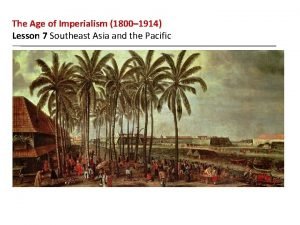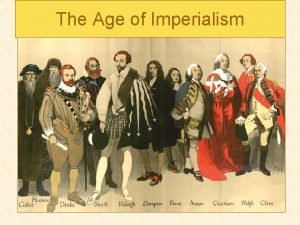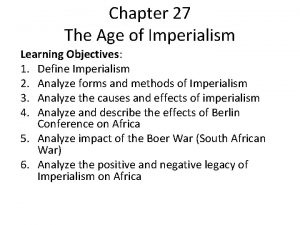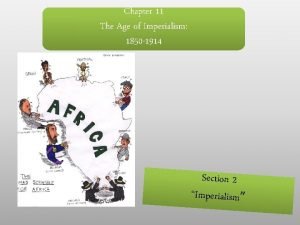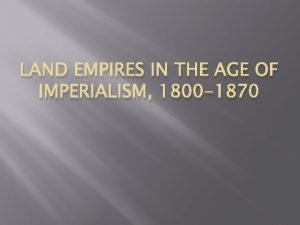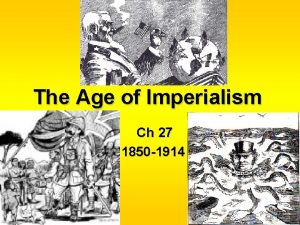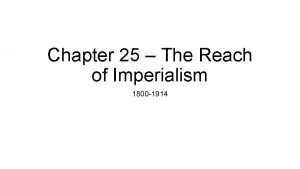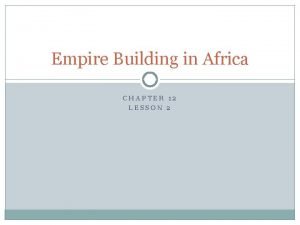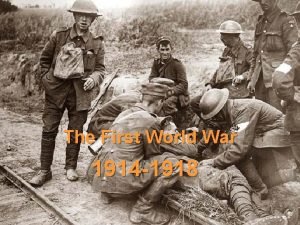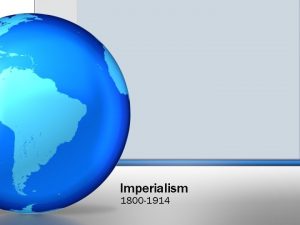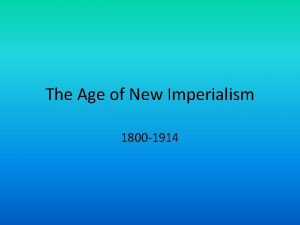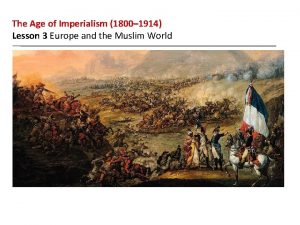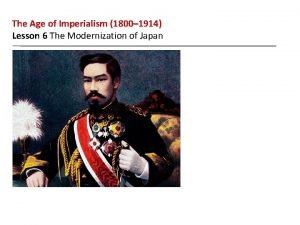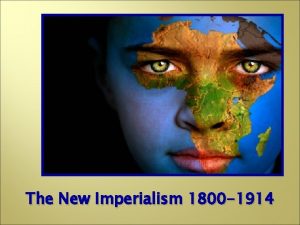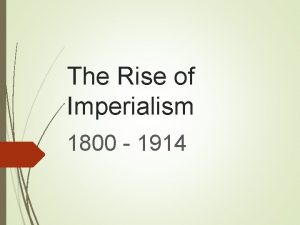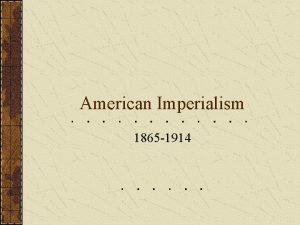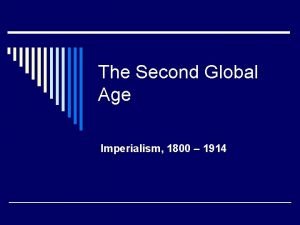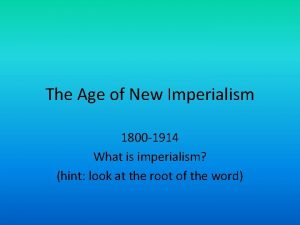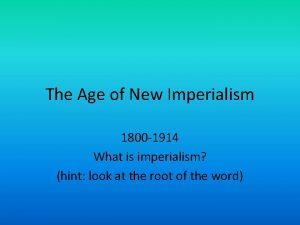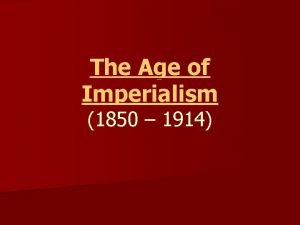The Age of Imperialism 1800 1914 Lesson 4




















- Slides: 20

The Age of Imperialism (1800– 1914) Lesson 4 India Becomes a British Colony

The Age of Imperialism (1800– 1914) Lesson 4 India Becomes a British Colony Learning Objectives • • Understand the causes and effects of the Sepoy Rebellion. Explain the impact of British rule on India. Describe how the British and Indians viewed one another. Trace the origins of Indian nationalism.

The Age of Imperialism (1800– 1914) Lesson 4 India Becomes a British Colony Key Terms • • • sati sepoys, viceroy deforestation, Ram Mohun Roy purdah

The British East India Company During the 1500 s and 1600 s, the Mughals presided over a powerful empire in India. By the mid-1700 s, however, the Mughal empire was in decline. When Mughal rulers were strong, the British East India Company gained only limited trading rights on the fringe of the empire.

The British East India Company • • • Exploitation of Indian Diversity Implementation of British Policies Increasing Discontent The Sepoy Rebellion Impact of the Rebellion

The British East India Company Draw Conclusions An official of the British East India Company rides in an Indian procession in the early 1800 s. How does the painting convey the power of the British?

India Under British Rule After 1858, Parliament set up a system of colonial rule in India which became known as the British Raj. A British viceroy in India governed in the name of the queen, and British officials held the top positions in the civil service and army. Indians filled most other jobs. With their cooperation, the British made India the “brightest jewel” in the crown of their empire.

India Under British Rule • • • An Unequal Partnership The Strain of Population Growth Benefits of British Colonial Rule

India Under British Rule This railway station was built in India in 1878 during the British Raj. British architects incorporated traditional Indian architectural features into the design.

India Under British Rule Support a Point of View with Evidence The graph and timeline show some effects of the British Raj. All things considered, was British rule a positive or a negative for India? Why?

Diverse Views on Culture Some educated Indians, impressed by British power and technology, urged India to follow a Western model of progress. These mostly upper-class Indians had learned English and adopted many Western ways. Other Indians felt that the path to freedom lay within their own Hindu or Muslim cultures.

Diverse Views on Culture • • Indian Attitudes Westerner Attitudes

Diverse Views on Culture In the early 1800 s, Ram Mohun Roy, a scholar known as the father of Indian nationalism, tried to reform traditional Indian culture.

The Growth of Indian Nationalism Under British rule, a class of Western-educated Indians emerged. The British expected this elite class to support British rule. As it turned out, exposure to European ideas had another effect. By the late 1800 s, Western-educated Indians were spearheading a nationalist movement. Schooled in Western ideals such as democracy and equality, they were determined to end foreign rule.

The Growth of Indian Nationalism • • Indian National Congress Formation of the Muslim League

The Growth of Indian Nationalism AC Mazumdar served as president of the Indian National Congress, which pushed for self-rule for India.

Quiz: The British East India Company What was one effect of the Sepoy Rebellion? A. B. C. D. The British Parliament extended the rule of the East India Company. The British ended the rebellion without hurting any Indian civilians. The British increased reforms, attempting to convert Indians to Christianity. The British Parliament put India under the rule of the British government and monarch.

Quiz: India Under British Rule How did British colonial rule affect education in India? A. There was not a major effect, since only British students were allowed a western education. B. A majority of people in India took advantage of new British schools to gain a better education. C. New British schools mostly benefited the sons of wealthy Indian families. D. New British schools mostly benefited farmers, who learned new agriculture techniques.

Quiz: Diverse Views on Culture How did Ram Mohun Roy hope to transform Indian culture and society? A. He wanted to combine Hindu customs related to women with British education for Indians. B. He wanted to start an Indian nationalism movement for independence from British rule. C. He wanted to modernize education in India while restoring pride in Indian culture. D. He wanted to keep India’s caste system but require Indians to learn English.

Quiz: The Growth of Indian Nationalism What was a difference between the Indian National Congress and the Muslim League? A. B. C. D. The Muslim League did not want to end British rule. The Muslim League wanted a separate Muslim state. The Indian National Congress did not allow Muslims to participate. The Indian National Congress wanted to consider a separate Hindu state.
 Imperialism map 1914
Imperialism map 1914 Contrast siam’s fate to that of burma and vietnam.
Contrast siam’s fate to that of burma and vietnam. Stone age chronology
Stone age chronology Iron age bronze age stone age timeline
Iron age bronze age stone age timeline Africa 1890
Africa 1890 Old vs new imperialism chart
Old vs new imperialism chart When did hawaii get statehood
When did hawaii get statehood Chapter 27 building vocabulary the age of imperialism
Chapter 27 building vocabulary the age of imperialism Chapter 27 building vocabulary the age of imperialism
Chapter 27 building vocabulary the age of imperialism Chapter 11 the age of imperialism
Chapter 11 the age of imperialism Land empires in the age of imperialism
Land empires in the age of imperialism Chapter 27 the age of imperialism
Chapter 27 the age of imperialism White man's burden apush
White man's burden apush The reach of imperialism
The reach of imperialism Chapter 25 lesson 2 empire building in africa
Chapter 25 lesson 2 empire building in africa Lesson 1: the new imperialism
Lesson 1: the new imperialism In 1914 who controlled the shaded areas on the map
In 1914 who controlled the shaded areas on the map Európa térképe 1914-ben
Európa térképe 1914-ben Colonial empires 1914
Colonial empires 1914 Dinant 1914
Dinant 1914 Bandera triple entente
Bandera triple entente

